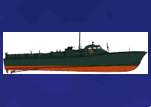 |
 |
 |
 |
 |
 |
 |
 |
 |
 |
 |
 |
 |
 |
 |
 |
 |
 |
|
Converting the Lindberg 1:80 scale
“Coastal Patrol Boat” into a
Patrol, Gunboat, Motor (PGM)
of the South Vietnamese Navy
|
Photos By: Joe Caputo, President of IPMS-Ocala
Article By: Joe Caputo, President of IPMS-Ocala
Model By: Joe Caputo, President of IPMS-Ocala
|
Beginning
This article is to how to do a conversion of the Lindberg "Coastal Patrol Boat", Kit No. 7409M into a South Vietnamese Navy's Patrol, Gunboat, Motor (PGM) that saw action in the Vietnam War. Let me start from the beginning. I had two of the Lindberg boats. I asked Mr. Connelly if I could build two different versions of this boat. He suggested I try converting it to a PGM. We both went searching for information. My info came from the Squadron publication, "Riverine" by Jim Mesko. In addition to this, Mr. Connelly graciously supplied more pictures, drawings, and the place I could obtain some accurate armament, fire hoses, etc. He also provided a great deal of patience in answering the many, many questions, of a non-ship building modeler. It was a really interesting and rewarding project. I now have an unusual piece that stands out in my small, approximately 1/72 scale, collection.
Construction |
|
First, I studied the instructions and made several drawings of my own. When you are studying a drawing less than 6 inches long, you miss a few things that come to light later in the project. The hull and deck would remain basically stock, removing molded in rocket launching platforms. |
|
Secondly, the front of the "cabin" had to be rebuilt and the "side walls", cut back. The front was constructed from one of those unused, unsolicited credit cards. Port holes were drilled out and later filled with "Elmers Glue", drying clear.
Third, moving aft, as you ship guys say. A sheet of "Evergreen Plastic", Item No. 4001, was used to construct the sides of the "crew quarters" or ammunition storage lockers. Doors were added. A trip to my local plant nursery yielded a plastic "price tag", large enough to make a roof for this part of the structure. The smoke stack is stock and in the standard location. A study of the top view of this boat reveals that the deck abaft the smoke stack had an unusual shape to accommodate several guns. |
|
Fourth. A tarp constructed of a thin plastic sheet (credit card), framed with stretched sprue, and covered with thinned Elmer's soaked tissue. This was supported by some very thin wooden dole. The stock life boat was repositioned on deck. Thanks to Mr. Connelly's suggestion, I was put in touch with HR Products where I was able to find the guns that put the gun in gunboat! I can't say enough about HR. They were fast, friendly, and have a great product. Once I received everything, (correct the first time), I did a little computer research on how the guns were supposed to look and assembled them. The white metal parts required very little cleanup and when painted, looked good. The price was right too. I also added a couple 50 caliber machine guns from my aircraft parts box. After all was assembled, more sprue was stretched for the stanchions, railings, and ladders, both on the upper deck and on the hull, per drawings.
Painting
The lower hull was painted red oxide, masked, black, masked, then a light gray to match the upper deck. Surfaces were all a dark gray. The wheel-house room roof was painted with a yellow square with a red X, which was utilized as an identification aide. The guns were painted as per reference.
Conclusion
While it may appear a lot easier than it was, most of the time/labor was with measuring, cutting and fitting. A lot of cardboard templates helped and saved valuable plastic sheets. I'm pleased with the result. Once again, thanks to Mr. Connelly and HR Products.
|
|
|
|
 |
| |
 |
 |
 |
 |
|